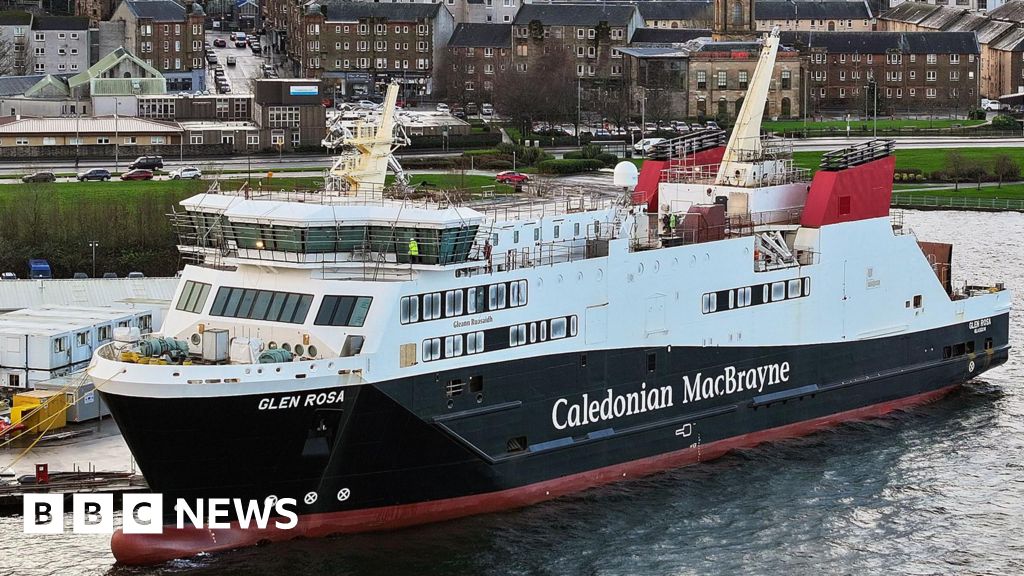Cloud Strife
Established Member
- Joined
- 25 Feb 2014
- Messages
- 2,384
Another day, another delay:

 www.bbc.com
www.bbc.com
As much as I'm an SNP supporter, it's painfully obvious that there were some serious internal political problems affecting 801 and 802 (the build names for Glen Sannox and Glen Rosa). I still don't think we know who was responsible for the high level specification that demanded the use of LNG, although it seems that CalMac were deeply unhappy about having an LNG-powered ship forced on them when it wasn't really suitable for their needs. CMAL are unsurprisingly in denial, but anyone that's dealt with CMAL knows that they tend to blame CalMac for everything.
The whole thing was clearly about giving Ferguson's the work, but it was a grave mistake to assume that they could deal with a difficult LNG build when they were already running on a skeleton operation.
The worst thing is that if they had waited a few years more, we could've had two fully electric ferries on the Ardrossan-Brodick route instead. It's already seen in Norway and Denmark that existing diesel-powered ferries can be transformed into electric ones, and there are some technologies that could easily have been adopted for use in Scotland, such as incorporating wind turbines to power onboard services.
Nothing serious, but this is a general Scottish Office / Scottish Government problem of not building relatively simple infrastructure. Most of the islands could and should have had fixed links built years ago.
I've always thought that one of the major missing pieces of infrastructure in Scotland is to build a Dunoon-Gourock tunnel as it would only need about a 3km tunnel. It's nothing major in European terms, and if it was combined with a Rhubodach-Colintraive bridge, Rothesay and Bute would finally receive a reliable link to Glasgow and beyond. The ferry could then be downsized to a passenger-only operation.

Ferguson shipyard confirms new delay for CalMac ferry Glen Rosa
The dual-fuel ship MV Glen Rosa, destined for the Arran route, is now due to be delivered next summer, nearly eight years late.
The delivery date for MV Glen Rosa, the second of two dual-fuel CalMac ferries being built by the nationalised Ferguson shipyard, has been put back by up to nine months.
The cost of the ship has also risen - by up to £35m - meaning the two ships will cost upwards of £460m, more than four-and-a-half times the original contract price.
Ferguson Marine said it now expected Glen Rosa to be "substantially complete" in the first quarter of 2026 and delivered between April and June.
The ship, which is to serve CalMac's Arran route, was originally due for delivery in July 2018.Top
MV Glen Rosa was launched from the Ferguson slipway in Port Glasgow a year ago in a far more finished state than its identical sister ship MV Glen Sannox seven years earlier.
While there was much "fitting out" work still to be done, including specialist cryogenic pipework for its liquefied natural gas (LNG) engines, it was hoped it could be delivered by the end of September this year.
As much as I'm an SNP supporter, it's painfully obvious that there were some serious internal political problems affecting 801 and 802 (the build names for Glen Sannox and Glen Rosa). I still don't think we know who was responsible for the high level specification that demanded the use of LNG, although it seems that CalMac were deeply unhappy about having an LNG-powered ship forced on them when it wasn't really suitable for their needs. CMAL are unsurprisingly in denial, but anyone that's dealt with CMAL knows that they tend to blame CalMac for everything.
The whole thing was clearly about giving Ferguson's the work, but it was a grave mistake to assume that they could deal with a difficult LNG build when they were already running on a skeleton operation.
The worst thing is that if they had waited a few years more, we could've had two fully electric ferries on the Ardrossan-Brodick route instead. It's already seen in Norway and Denmark that existing diesel-powered ferries can be transformed into electric ones, and there are some technologies that could easily have been adopted for use in Scotland, such as incorporating wind turbines to power onboard services.
Does anyone know if there has been any serious consideration about a bridge on the Rhubodach-Colintraive route?
Nothing serious, but this is a general Scottish Office / Scottish Government problem of not building relatively simple infrastructure. Most of the islands could and should have had fixed links built years ago.
did consider it as part of a wider North Ayrshire-Little Cumbrae-Bute-Cowal bridge route, but not on its own merits.
I've always thought that one of the major missing pieces of infrastructure in Scotland is to build a Dunoon-Gourock tunnel as it would only need about a 3km tunnel. It's nothing major in European terms, and if it was combined with a Rhubodach-Colintraive bridge, Rothesay and Bute would finally receive a reliable link to Glasgow and beyond. The ferry could then be downsized to a passenger-only operation.
